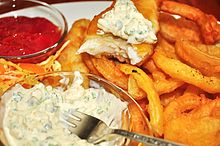Tartar sauce: Difference between revisions
Rescuing 1 sources and tagging 0 as dead. #IABot (v1.5beta) |
|||
| Line 41: | Line 41: | ||
* [http://www.straightdope.com/mailbag/mtartar.html An explanation of the name's origin, from The Straight Dope] |
* [http://www.straightdope.com/mailbag/mtartar.html An explanation of the name's origin, from The Straight Dope] |
||
* [http://rinfom.com/kitchen/327-tartar Tartar sauce and steak] |
* [http://rinfom.com/kitchen/327-tartar Tartar sauce and steak] |
||
* [http://allrecipes.com/advice/ref/ency/terms/8847.asp A definition at Allrecipes.com] |
* [https://web.archive.org/web/20050404013623/http://allrecipes.com/advice/ref/ency/terms/8847.asp A definition at Allrecipes.com] |
||
{{Mayonnaise-based sauces}} |
{{Mayonnaise-based sauces}} |
||
Revision as of 04:16, 27 July 2017
 Tartar sauce is often served with fried seafood. | |
| Alternative names | Tartare |
|---|---|
| Type | Sauce |
| Place of origin | Europe |
| Main ingredients | Mayonnaise, capers, gherkins, lemon juice and tarragon |
Tartar sauce (in the UK, New Zealand and Australia, tartare sauce) is a mayonnaise or aioli-based sauce, typically of a rough consistency. It is often used as a condiment with seafood dishes.[1]
Composition
Tartar sauce is based on either mayonnaise (egg white, mustard or vinegar, oil) or aioli (egg white, olive oil, garlic, lemon juice), with certain other ingredients added. In the UK, recipes typically add to the base capers, gherkins, lemon juice, and dill. US recipes may include chopped pickles or prepared green sweet relish, capers, onions (or chives), and fresh parsley.[1] Chopped hard-boiled eggs or olives are sometimes added, as may be Dijon mustard and cocktail onions.[2] Paul Bocuse describes sauce tartare explicitly[3] as a sauce remoulade,[4] in which the characterising anchovy purée is to be substituted by some hot Dijon mustard.
History and etymology

The sauce and its name have been found in cookbooks since the 19th century. The name derives from the French sauce tartare, named after the Tatars (ancient spelling in French of the ethnic group: tartare) from the Eurasian Steppe, who once occupied parts of Russia.[5]
See also
References
- ^ a b Isabella Graham Duffield Stewart; Mary B. Duffield (1878). The Home messenger book of tested receipts. Detroit: E. B. Smith & Co. p. 31. Retrieved 2 June 2012.
- ^ Louisette Bertholle; Julia Child; Simone Beck (2001). Mastering the Art of French Cooking. Vol. 1. New York: Alfred A. Knopf. ISBN 978-0-307-95817-4. Retrieved 2 June 2012.
- ^ Paul Bocuse, La cuisine du marché, 1976
- ^ Bocuse describes the Remoulade just previous Sauce Tartare as a standard mayonnaise (egg yolks, vinegar, oil) with additional chopped capers, gherkins and herbs and some anchovy purée
- ^ "tartar". Online Etymology Dictionary. Douglas Harper. 2001–2002. Retrieved 2 June 2012.

